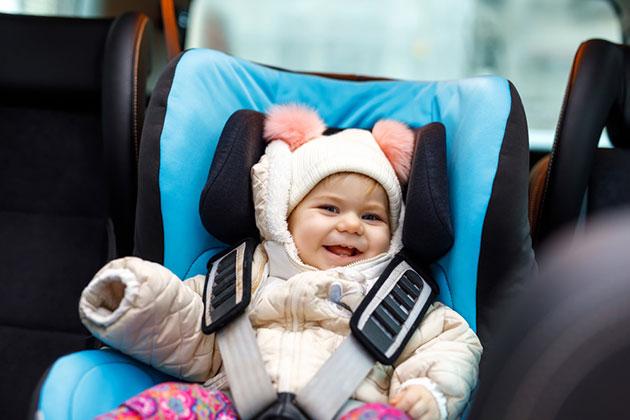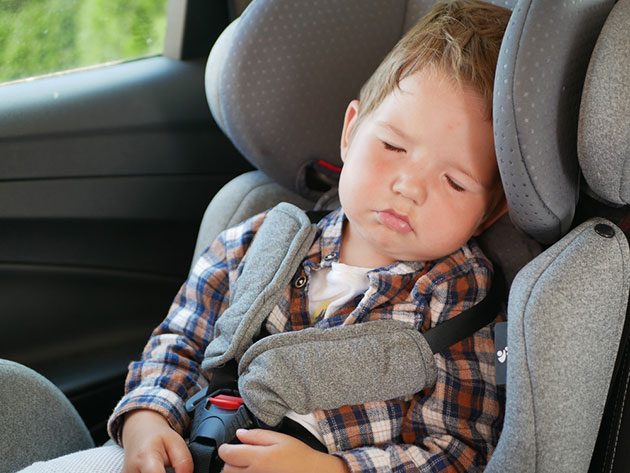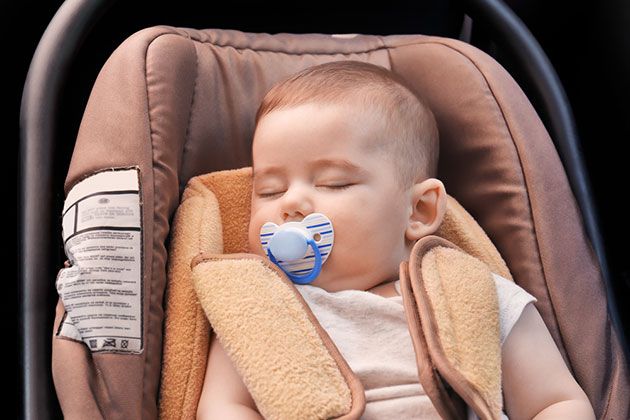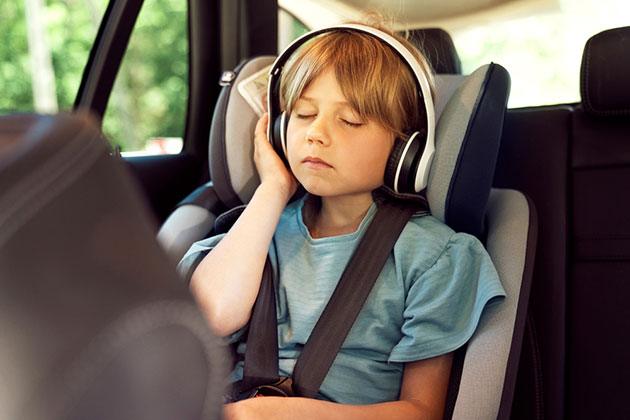"Can I place my 4-year-old in a booster seat? When's the right time for my child to use a booster car seat?"
It seems that parents hurry to place their little ones into boosters, which is a great mistake since every rush transition reduces safety.
According to the NHTSA and AAP, it would be best if you keep your little ones in forward-facing car seats for as long as possible until they're developed and ready enough for booster seats.
But, what's the exact moment when to use booster seats?
Find below.
More...
How to Keep Your Child Safe in Car Seats?

According to the Consumer Reports' child safety experts, you can think that it's safe to transition your child from one car seat to the next level, but it might not match the instructions the seat manufacturer recommends.
This practice seems to neglect what the authorities, experts, and child passenger safety technicians recommend and leans only on the car seat manufacturer specifications.
Therefore, you could notice various publications of numerous non-profit organizations stating that there are booster seats suitable for children of 30 pounds or even less.
This is unacceptable!
Once you come across these articles, please, disregard them.
The only sound sources are the National Highway Traffic Safety Administration, the American Academy of Pediatrics, safety technicians, verified authorities, and other experts.
In addition, the AAP claims that kids weighing 30 pounds should remain in the forward-facing car seat with a five-point harness.
So, all authorized CPSTs will recommend you safely ride your kids harnessed for an extended period to increase safety and security on the road.
Car seat manufacturers perform various side-impact protection tests, safety tests, performance, and quality tests; yet, they never publish their achievements.
Since the results are unpublished, the statements may vary among producers, not indicating the standardized measures regarding side-impact protection from a car seat to another one.
The NHTSA was supposed to invent and determine standard tests regarding the side-impact protection, but their efforts faded away.
For this reason, various studies have shown that car seats are the most effective devices to protect children, reduce risks of severe injuries, and omit fatal consequences.
Thus, in a car accident, when using an appropriate car seat correctly, you will reduce the risk by 71 to 82% and by 45% when using a booster seat (compared to the use of the vehicle's seat belt only).
Thus, as you can conclude, the use of any car seat is much better than using none.
However, parents and caregivers should remember that height and weight limits, age labels, and instructions might not always be the best suggestions for a child's overall safety.
Children are better restrained, and therefore more safe and stable in the 5-point harness forward-facing car seat than the belt-positioning booster.
So, parents should follow the NHTSA's recommendations, height and weight limits charts to properly use age-appropriate car seats for their children.
So, When Is the Right Transition?

Although you might think that your child meets the correct height limit and weight limit, so they're ready for the next car seat level, you should consider many things.
One of the main factors is age.
Age determines the child's skeletal development, ensuring they're strong enough for the correct child restraint system and withstanding external forces in a car accident.
So, when you allow your child to use a forward-facing car seat with a harness and meet the weight and height limits, you can be confident they're strong enough to use a booster seat.
Another factor is that a child using a booster seat must sit upright using a proper seat belt fit for the entire car ride.
So, the shoulder belt and lap belt must adequately cover the child's body parts.
Thus, the proper belt fit implies the shoulder belt covers the chest instead of the neck, and the lap belt covers the child's upper thighs instead of the stomach.
Numerous harnessed seats - a forward-facing convertible seat, a toddler-booster seat (or harness-to booster seats), and all-in-one car seats have a weight limit of 65 pounds or even more when used forward-facing.
So, some parents can keep their children in the harnessed seat for ample time instead of using booster seats for 30 or 40 pounds of weight, as some manufacturers indicate.
However, once the child outgrows the weight and height limits, the school-age children can use booster car seats.
Boosters must have a seat belt properly installed to reduce crash forces in frontal and side-impact car crashes.
They must be installed in the back seat.
The same rule applies to the transition from a rear-facing car seat to a forward-facing seat for younger children.
Most convertible car seats, offering both a rear-facing position and a forward-facing mode, allow children between 20 and 22 pounds to use the forward-facing mode.
However, this doesn't imply that the minimum and maximum weight or height limits are the ideal time to make this transition.
So, according to the Consumer Reports and the AAP's research, a child should remain in the rear-facing car seat until they're 2-years-old, or until they exceed the maximum weight or height limits of the rear-facing car seat.
This means that the child weighs more than 20 or 22 pounds.
What About Booster-age Kids?
For parents using any boosters, yet their kids are younger than four and weigh less than 40 pounds, the Consumer Reports and NHTSA recommend you bring them back into the forward-facing seat.
However, if your child weighs 40 pounds and more and is more than four years old, they can continue to use their boosters.
Still, you have to make sure the seat belt fits them properly, and the child can remain in the proper position during the whole trip.
Yet, if you haven't moved kids into boosters yet, keep them in forward-facing seats for as long as possible.
There's no need to rush.
What Are the Official Car Seat Recommendations?

As you can find at the NHTSA official site, you can find the correct car seat use below.
First, however, you need to follow the safety procedure:
- Pick a car seat matching your child's height and weight, and then choose a car seat fitting your vehicle seat and vehicle installation features.
- Always follow the car seat manufacturer's instructions (height and weight limits), and read the vehicle owner's manual to check whether the car seat is permitted both by the car seat vehicle manufacturers.
The vehicle owner's manual will help you to install the car seat using the vehicle seat belt or a tether and lower anchors, if possible.
- To increase safety, keep your child in the car seat for as long as possible until they overgrow the maximum weight and height recommended by the manufacturer.
- Install all car seats in the back seat, and keep your kids at the back until they're 12 or 13 years old.
Car Seat Use
1. Rear-facing Seat (Birth-12 Months and 1-3 Years)
All children younger than one must be adequately restrained in the rear-facing seat.
There are various types of rear-facing car seats:
1. Infant seats - the rear seats can be used only rear-facing.
2. Convertible seats - have greater weight and height limits, allowing them to stay in the rear-facing mode longer.
A convertible seat can be used as a forward-facing seat with a harness.
3. All-in-one seat - serves as a rear-facing, forward-facing, or booster car seat with a harness, tether, or seat belt as the kids grow.
2. Forward-facing Car Seat (1-3 Years & 4-7 Years)
Please keep your child in the rear-facing position for an extended period until they're ready to use a forward-facing car seat with a harness or a tether.
Once your child outgrows the forward-facing seat, you can place them into booster seats.
The types include:
- Convertible seats: offering both rear-facing and forward-facing modes
- Combination seats: transition from a forward-facing harnessed or tethered seat to a booster
- All-in-one seats: rear-facing, forward-facing, and booster seats
3. Booster Seat (4-7 and 8-12 Years)

Please keep your child into a forward-facing mode until they're old enough for a belt-positioning booster seat in the back seat.
Later on, place your child in the booster seat until the child outgrows the seat for an adult seat belt system.
Many models offer safety belt positioners.
The safety belt attachments keep the shoulder and lap straps correctly.
Booster seat manufacturers offer these primary types:
1. High-back booster - a car seat features a child's back to sit upright, so the seat belt fits them properly.
It also includes head and neck support for vehicles without a high seat back or headrest.
2. Backless boosters - ideal for vehicles with headrests, and they don't have head and neck support but use a seat belt.
3. Harness boosters - provide a five-point harness system for more stability.
The lap and shoulder belts cover the upper thighs and the chest.
4. Seat Belts
Once children outgrow the boosters, you can place them in the back seat with seat belts.
Make sure you keep them in boosters until the seat belt fits properly on their body. The lap belts and shoulder belts cover the chest and upper thighs for proper use and installation.
Your child can sit in the front seat with seat belts in numerous passenger vehicles once they're 12 or 13, depending on the car seat law.
Bear in mind that all child restraint systems meet Federal Safety Standards and Strict Crash Performance Standards, and child passenger safety technicians test them.
FAQs
When can a child use a backless booster seat?
Once their height and weight meet the specifications, or when they're between 8 and 12 years old.
When should I use a high back booster?
When your kid is between 8 and 12 years old and 4 feet 9 inches tall.
How much do you have to weigh to get out of a booster seat?
Between 80 and 100 pounds.
Summary
So, when is your child ready for a booster seat?
Well, children should remain in their forward-facing seats for ample time, but once they're 8-12 years, and 4 feet 9 inches tall, they can use boosters.
First, however, you need to place them in the back seat and ensure the seat belt is installed correctly.
Then, ensure they're stable and safe.
I hope you found all the crucial points regarding boosters, and the article helped you.
But, for additional dilemmas, leave a comment below.
